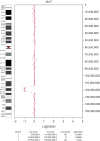1. Marquer A, Barbieri G, Pérennou D. The assessment and treatment of postural disorders in cerebellar ataxia: a systematic review. Ann Phys Rehabil Med. 2014; 57:67–78.


3. Renaud M, Tranchant C, Martin JV, Mochel F, Synofzik M, van de Warrenburg B, Pandolfo M, Koenig M, Kolb SA, Anheim M, Alonso I, Azzedine H, Barbot C, Bereau M, Berkovic S, Bernard G, Bindoff LA, Bompaire F, Bonneau D, Bonneau P, Boycott KM, Bras J, Brais B, Brigatti KW, Cameron J, Chamova T, Choquet K, Delague V, Denizeau P, Dotti MT, El-Euch G, Elmalik SA, Federico A, Fiskerstrand T, Gagnon C, Guerreiro R, Guissart C, Hassin-Baer S, Heimdal KR, Héron B, Isohanni P, Kalaydijeva L, Kawarai T, Koht JA, Lai SC, Piana RL, Lecocq C, Linnankivi T, Lönnqvist T, Lu CS, Maas R, Mahlaoui N, Mallaret M, Marelli C, Mariotti C, Mathieu J, Méneret A, Mignarri A, Monin ML, Montaut S, Nanetti L, Nadjar Y, Poujois A, Salih MA, Sousa S, Stanier P, Stoppa-Lyonnet D, Strauss K, Tallaksen C, Tarnopolsky M, Tinant N, Tournev I, Topaloglu H, Varhaug KN, Woimant F, Wolf NI, Yahalom G, Yoon G, Young M. RADIAL Working Group. A recessive ataxia diagnosis algorithm for the next generation sequencing era. Ann Neurol. 2017; 82:892–899.


4. Gatti RA, Berkel I, Boder E, Braedt G, Charmley P, Concannon P, Ersoy F, Foroud T, Jaspers NG, Lange K, Lathrop GM, Leppert M, Nakamura Y, O'Connell P, Paterson M, Salser W, Sanal O, Silver J, Sparkes RS, Susi E, Weeks DE, Wei S, White R, Yoder F. Localization of an ataxia-telangiectasia gene to chromosome 11q22-23. Nature. 1988; 336:577–580.


5. Sadakata T, Kakegawa W, Mizoguchi A, Washida M, Katoh-Semba R, Shutoh F, Okamoto T, Nakashima H, Kimura K, Tanaka M, Sekine Y, Itohara S, Yuzaki M, Nagao S, Furuichi T. Impaired cerebellar development and function in mice lacking CAPS2, a protein involved in neurotrophin release. J Neurosci. 2007; 27:2472–2482.



6. Grabowski PA, Bello AF, Rodrigues DL, Forbeci MJ, Motter V, Raskin S. Deletion involving the 7q31-32 band at the CADPS2 gene locus in a patient with autism spectrum disorder and recurrent psychotic syndrome triggered by stress. Case Rep Psychiatry. 2017; 2017:4254152.

8. Speidel D, Bruederle CE, Enk C, Voets T, Varoqueaux F, Reim K, Becherer U, Fornai F, Ruggieri S, Holighaus Y, Weihe E, Bruns D, Brose N, Rettig J. CAPS1 regulates catecholamine loading of large dense-core vesicles. Neuron. 2005; 46:75–88.


9. Sadakata T, Washida M, Iwayama Y, Shoji S, Sato Y, Ohkura T, Katoh-Semba R, Nakajima M, Sekine Y, Tanaka M, Nakamura K, Iwata Y, Tsuchiya KJ, Mori N, Detera-Wadleigh SD, Ichikawa H, Itohara S, Yoshikawa T, Furuichi T. Autistic-like phenotypes in Cadps2-knockout mice and aberrant CADPS2 splicing in autistic patients. J Clin Invest. 2007; 117:931–943.



10. Courchesne E, Yeung-Courchesne R, Press GA, Hesselink JR, Jernigan TL. Hypoplasia of cerebellar vermal lobules VI and VII in autism. N Engl J Med. 1988; 318:1349–1354.










 PDF
PDF Citation
Citation Print
Print



 XML Download
XML Download